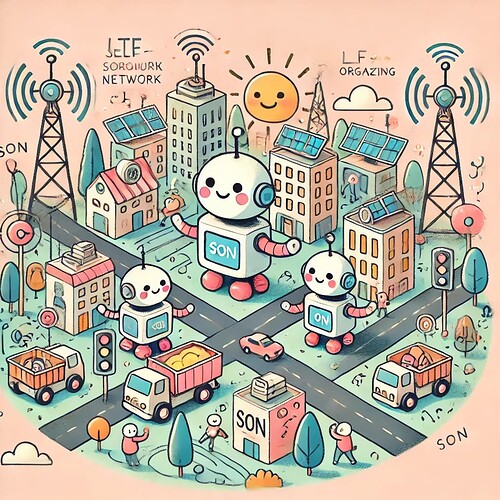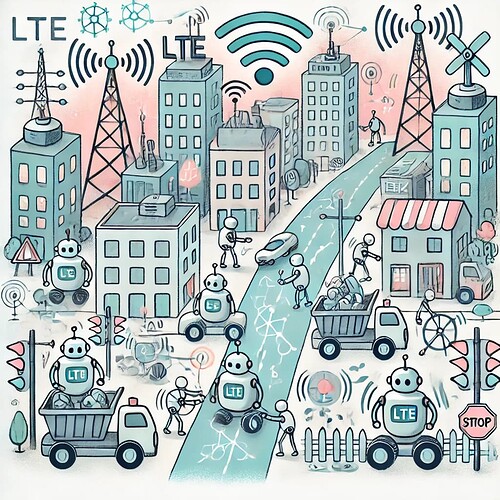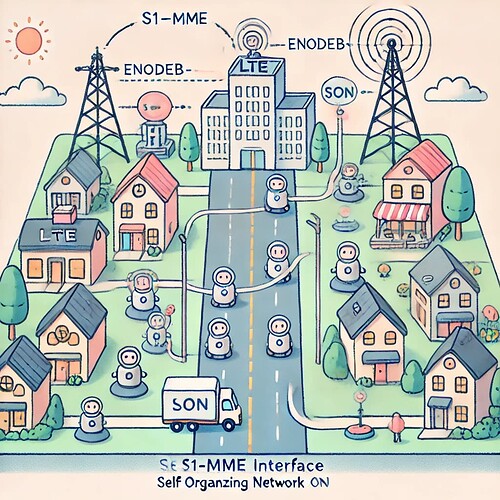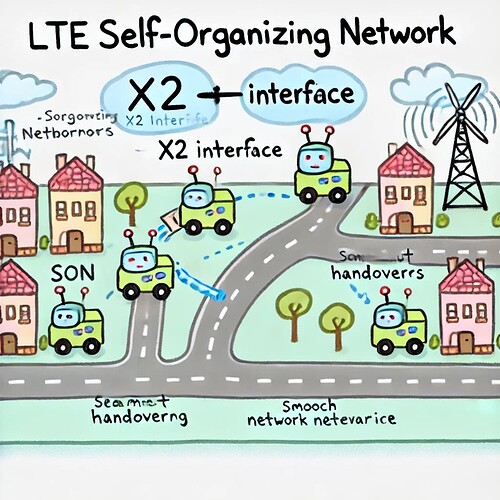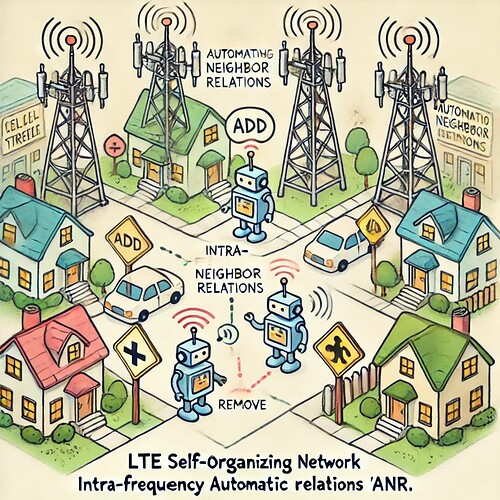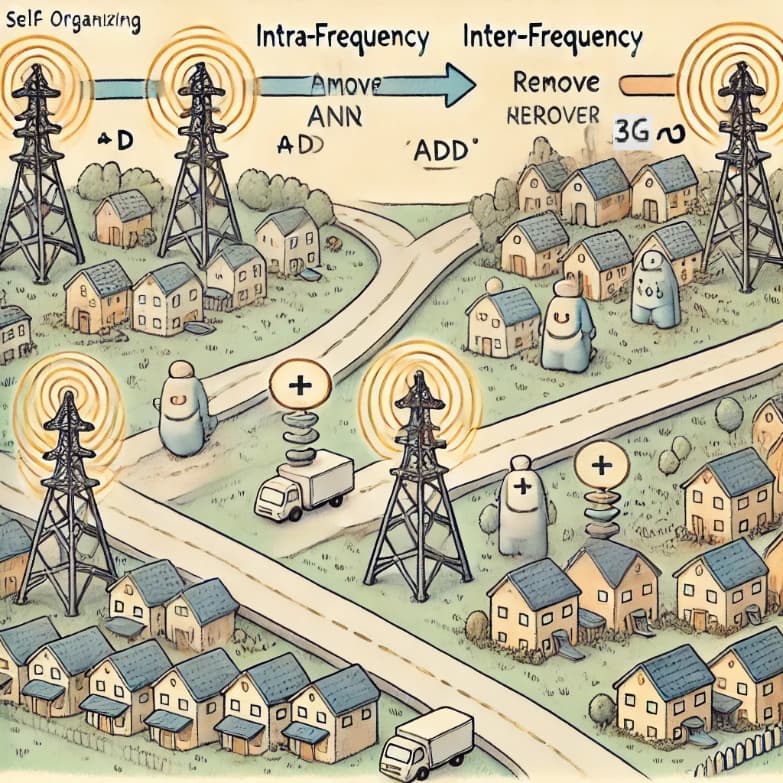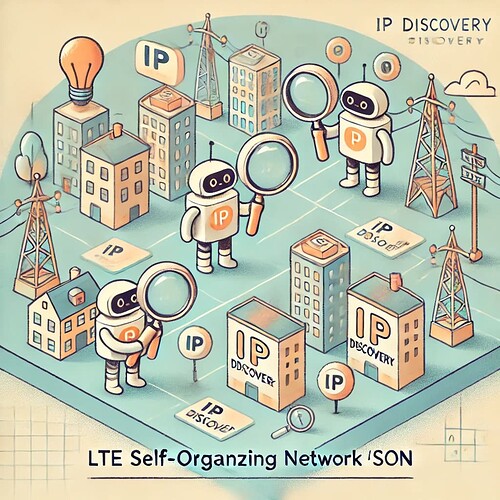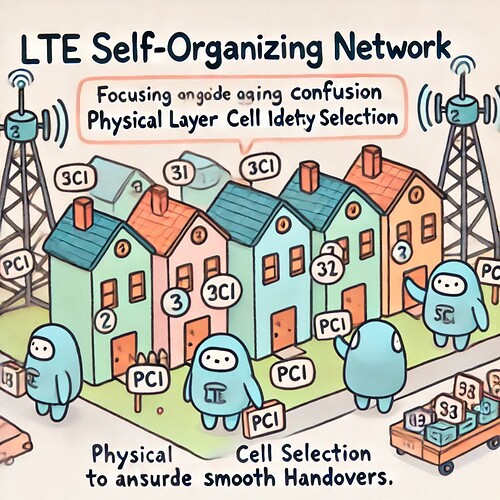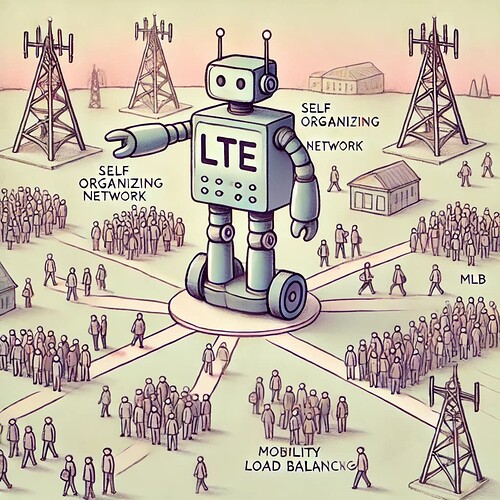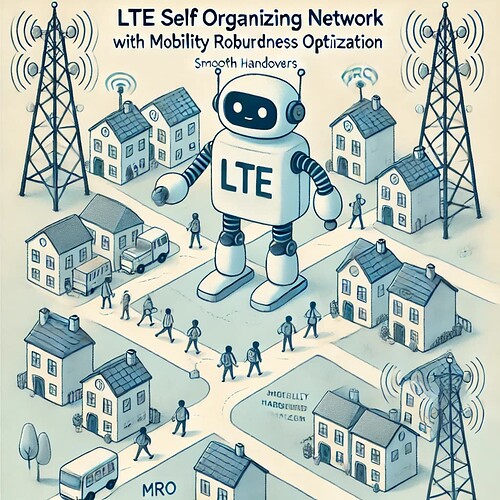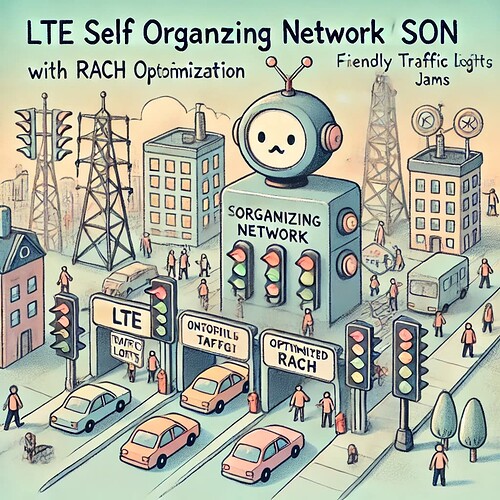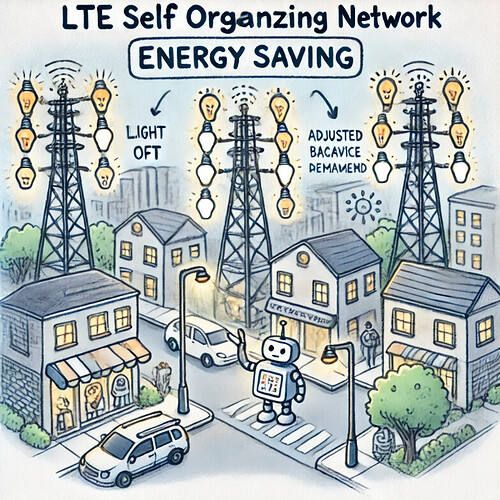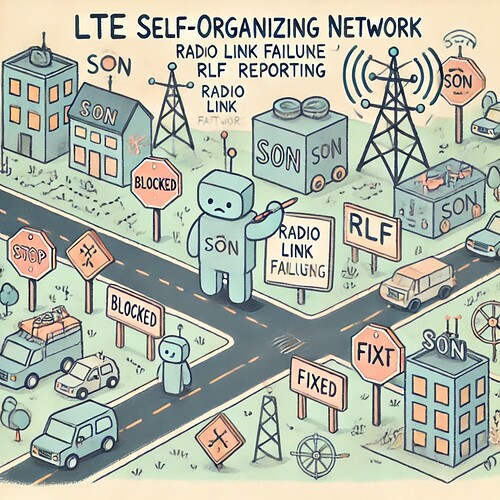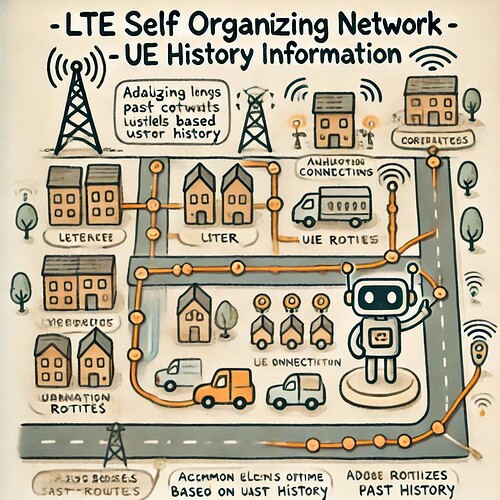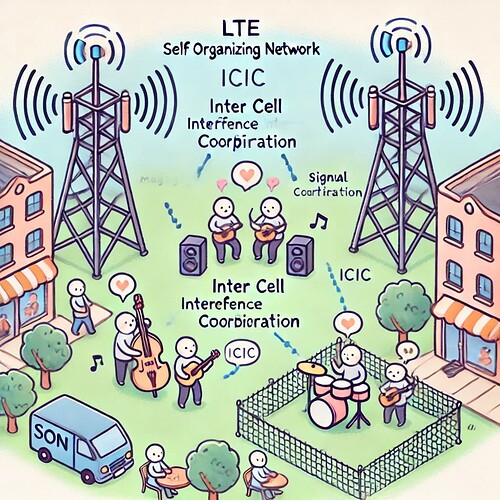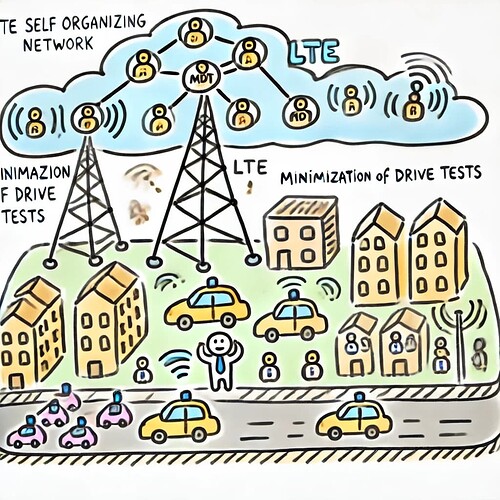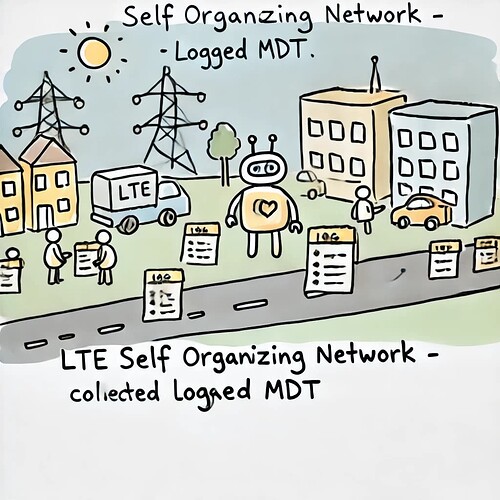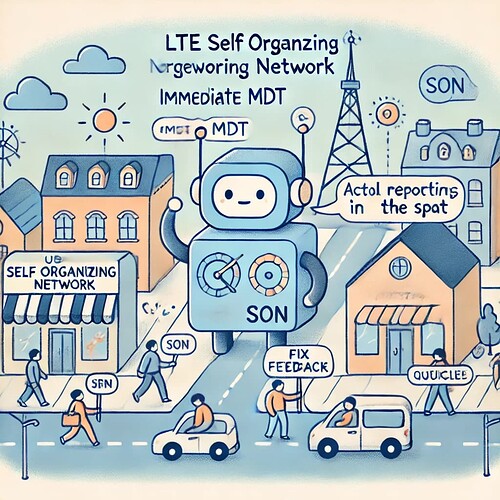This topic presents in a very simplified way all the main concepts that should be understood by those who know LTE.
LTE Self Organizing Network
Self-Organizing Networks (SON) in LTE are automated systems designed to manage and optimize network performance with minimal human intervention. The primary goal of SON is to enhance the efficiency, reliability, and capacity of the network by automating processes like configuration, maintenance, and optimization. Key characteristics of SON include self-configuration, where the network automatically sets up new base stations and connections; self-optimization, which adjusts network parameters like signal strength to improve user experience; and self-healing, which detects and corrects faults or failures to maintain uninterrupted service. SON enables LTE networks to dynamically adapt to changes in traffic, user movement, and network conditions, improving overall performance and reducing operational costs. (In a Nutshell: SON automates LTE network setup, adjustment, and repair to enhance efficiency and reliability.)
![]() Imagine a city that can take care of itself without needing people to constantly fix things. That’s what a Self-Organizing Network (SON) is in LTE! SON is like a smart city that knows how to set up new roads and buildings when needed (self-configuration), adjust traffic lights and streets to keep things moving smoothly (self-optimization), and even fix potholes and broken streetlights on its own (self-healing). This helps everyone in the city stay connected easily, even if lots of people are using the network or if there’s a problem. SON keeps everything running smoothly, so people can call, text, and use the internet without interruptions. (In a Nutshell: SON is like a self-sustaining city, ensuring everyone stays connected without manual help.)
Imagine a city that can take care of itself without needing people to constantly fix things. That’s what a Self-Organizing Network (SON) is in LTE! SON is like a smart city that knows how to set up new roads and buildings when needed (self-configuration), adjust traffic lights and streets to keep things moving smoothly (self-optimization), and even fix potholes and broken streetlights on its own (self-healing). This helps everyone in the city stay connected easily, even if lots of people are using the network or if there’s a problem. SON keeps everything running smoothly, so people can call, text, and use the internet without interruptions. (In a Nutshell: SON is like a self-sustaining city, ensuring everyone stays connected without manual help.)
Skip to: Roadmap to LTE
- Self Organizing Network (SON) Introduction
- Configuration of S1-MME Interface
- Configuration of X2 Interface
- Intra-Frequency Automatic Neighbor Relations (ANR)
- Inter-Freq/System Automatic Neighbor Relations (ANR)
- Transport Network Layer (TNL) Address Discovery
- Physical Layer Cell Identity (PCI) Selection
- Mobility Load Balancing (MLB)
- Mobility Robustness Optimization (MRO)
- RACH Optimization
- Energy Saving
- Radio Link Failure (RLF) Reporting
- UE History Information
- Inter Cell Interference Coordination (ICIC)
- Minimization of Drive Tests (MDT)
- Logged MDT
- Immediate MDT
Self Organizing Network (SON) Introduction
Self-Organizing Network (SON) in LTE is an automated system designed to simplify network management and optimize performance. SON reduces the need for manual intervention by automatically configuring, managing, and adjusting network elements, making LTE networks more efficient, resilient, and responsive to changes in traffic or user demand. (In a Nutshell: SON automates network management, enhancing LTE efficiency and adaptability.)
![]() Imagine a city that can organize itself and make decisions without needing people to tell it what to do all the time. A city that can fix its own roads, manage traffic, and make sure everyone has electricity and water, helping your phone work better with less manual effort. That’s what an LTE SON is like! It’s a smart network that can fix itself, adjust when things get busy, and keep everything running smoothly. (In a Nutshell: SON is like a self-sufficient city that manages and fixes itself to keep everything running well.)
Imagine a city that can organize itself and make decisions without needing people to tell it what to do all the time. A city that can fix its own roads, manage traffic, and make sure everyone has electricity and water, helping your phone work better with less manual effort. That’s what an LTE SON is like! It’s a smart network that can fix itself, adjust when things get busy, and keep everything running smoothly. (In a Nutshell: SON is like a self-sufficient city that manages and fixes itself to keep everything running well.)
Configuration of S1-MME Interface
The S1-MME interface connects eNodeBs (base stations) to the Mobility Management Entity (MME), allowing communication between user devices and the Core network. SON automatically configures this interface, ensuring that eNodeBs have proper connections with the Core network to facilitate seamless user authentication, call setup, and data exchange. This interface is crucial for managing signaling and control messages related to user mobility, session management, and bearer establishment in the LTE network. (In a Nutshell: The S1-MME interface links base stations to the core, enabling smooth communication for user authentication, calls, and data.)
![]() The S1-MME Interface is like a city’s main road that connects neighborhoods (base stations) to the city center (network core). SON makes sure this road is always open and set up right, so people (signals) can travel easily between the neighborhoods and the city center. This is like setting up a major highway that connects different parts of the city to the control center. (In a Nutshell: S1-MME is like the city’s main road, connecting areas to keep communication flowing smoothly.)
The S1-MME Interface is like a city’s main road that connects neighborhoods (base stations) to the city center (network core). SON makes sure this road is always open and set up right, so people (signals) can travel easily between the neighborhoods and the city center. This is like setting up a major highway that connects different parts of the city to the control center. (In a Nutshell: S1-MME is like the city’s main road, connecting areas to keep communication flowing smoothly.)
Configuration of X2 Interface
The X2 Interface links eNodeBs directly, enabling fast communication for functions like handovers. SON configures these links to ensure smooth data transfer between base stations. This setup supports efficient resource sharing and quick user transitions as they move between different areas covered by eNodeBs. The X2 interface configuration is essential for direct communication between neighboring eNodeBs. This interface supports handovers, load balancing, and coordination of radio resources, ensuring seamless connectivity and efficient use of network resources as users move across different cell areas. (In a Nutshell: The X2 Interface directly connects base stations, facilitating fast data transfer and smooth handovers.)
![]() The X2 Interface is like a special shortcut road between neighborhoods. SON makes sure these shortcut roads are connected, so people can move between areas quickly without having to go through the busy city center every time. Think of the X2 Interface as smaller roads connecting neighborhoods. Setting these up makes sure data can easily move between different parts of the network. (In a Nutshell: X2 is like shortcut roads, enabling quick access between network areas.)
The X2 Interface is like a special shortcut road between neighborhoods. SON makes sure these shortcut roads are connected, so people can move between areas quickly without having to go through the busy city center every time. Think of the X2 Interface as smaller roads connecting neighborhoods. Setting these up makes sure data can easily move between different parts of the network. (In a Nutshell: X2 is like shortcut roads, enabling quick access between network areas.)
Intra-Frequency Automatic Neighbor Relations (ANR)
Intra-Frequency Automatic Neighbor Relations (ANR) in SON automatically manage the relationships between cells operating on the same frequency. SON identifies and updates neighbor cell lists, optimizing handovers within the same frequency to ensure stable connections as users move within the network. This function automatically updates the neighbor cell list, ensuring that the network can efficiently handle handovers and maintain connectivity without manual intervention. (In a Nutshell: Intra-Frequency ANR helps cells on the same frequency coordinate for smooth handovers and stable connections.)
![]() Intra-Frequency ANR is like knowing your neighbors who live on the same street. SON makes sure each neighborhood (cell) knows the nearby neighborhoods on the same street (frequency), so people can move around easily without losing connection. This is like neighbors within the same block helping each other. It ensures nearby cell towers can communicate and work together, providing better coverage. (In a Nutshell: Intra-Frequency ANR is like neighboring streets helping each other for easy movement and strong connections.)
Intra-Frequency ANR is like knowing your neighbors who live on the same street. SON makes sure each neighborhood (cell) knows the nearby neighborhoods on the same street (frequency), so people can move around easily without losing connection. This is like neighbors within the same block helping each other. It ensures nearby cell towers can communicate and work together, providing better coverage. (In a Nutshell: Intra-Frequency ANR is like neighboring streets helping each other for easy movement and strong connections.)
Inter-Freq/System Automatic Neighbor Relations (ANR)
Inter-Frequency/System Automatic Neighbor Relations (ANR) manage cell relationships across different frequencies or systems (e.g., LTE to 3G). SON keeps these relationships updated, allowing smooth handovers across different networks or frequency bands, which maintains consistent service quality as users move. This function ensures that handovers between different frequency layers or radio access technologies are smooth, maintaining service continuity and optimizing network performance. (In a Nutshell: Inter-Frequency/System ANR enables seamless transitions between different network types, keeping service consistent.)
![]() Inter-Freq/System ANR is like knowing your neighbors across different streets or neighborhoods. SON sets up connections so people can move from one neighborhood to another, even if it’s in a different part of town, like going from LTE to 3G. This is like neighbors from different parts of the city helping out. It ensures smooth connections even if you move to a different area or use a different network. (In a Nutshell: Inter-Freq/System ANR connects different neighborhoods, allowing seamless movement across network areas.)
Inter-Freq/System ANR is like knowing your neighbors across different streets or neighborhoods. SON sets up connections so people can move from one neighborhood to another, even if it’s in a different part of town, like going from LTE to 3G. This is like neighbors from different parts of the city helping out. It ensures smooth connections even if you move to a different area or use a different network. (In a Nutshell: Inter-Freq/System ANR connects different neighborhoods, allowing seamless movement across network areas.)
Transport Network Layer (TNL) Address Discovery
Transport Network Layer (TNL) Address Discovery helps eNodeBs identify IP addresses within the transport network layer. SON automates this process to ensure that eNodeBs can connect correctly to network routers and switches, simplifying setup and minimizing network configuration errors. It involves identifying and configuring the IP addresses used for communication between network elements. This process ensures that data packets are correctly routed through the network, facilitating efficient data transfer and connectivity. (In a Nutshell: TNL Address Discovery automatically finds and configures IP addresses to enable smooth data routing across the network.)
![]() TNL Address Discovery is like figuring out the addresses of all important buildings in the city. SON automatically finds these addresses so everyone in the network can get connected to the right place quickly. You can also think of it as finding the exact address of a house. It helps the network find the best paths to send data to the right place quickly and accurately. (In a Nutshell: TNL Address Discovery is like mapping addresses so that data reaches its destination accurately and efficiently.)
TNL Address Discovery is like figuring out the addresses of all important buildings in the city. SON automatically finds these addresses so everyone in the network can get connected to the right place quickly. You can also think of it as finding the exact address of a house. It helps the network find the best paths to send data to the right place quickly and accurately. (In a Nutshell: TNL Address Discovery is like mapping addresses so that data reaches its destination accurately and efficiently.)
Physical Layer Cell Identity (PCI) Selection
Physical Layer Cell Identity (PCI) Selection is the process of assigning unique identifiers to each cell in the network to avoid interference between neighboring cells. These identifiers are used for distinguishing between different cells, enabling accurate handovers and efficient management of radio resources. SON selects these identities automatically, which prevents confusion between cells and maintains network organization and coverage clarity. (In a Nutshell: PCI Selection assigns unique IDs to each cell, ensuring smooth handovers and reducing interference.)
![]() Imagine each neighborhood needs a unique number so everyone knows where they are. SON assigns these numbers to each area so they don’t get confused with others, even when they’re close by. It’s like giving each house a unique number. This helps the network identify and manage different cell towers, providing the best service. (In a Nutshell: PCI Selection is like numbering neighborhoods so signals don’t get mixed up.)
Imagine each neighborhood needs a unique number so everyone knows where they are. SON assigns these numbers to each area so they don’t get confused with others, even when they’re close by. It’s like giving each house a unique number. This helps the network identify and manage different cell towers, providing the best service. (In a Nutshell: PCI Selection is like numbering neighborhoods so signals don’t get mixed up.)
Mobility Load Balancing (MLB)
Mobility Load Balancing (MLB) optimizes the distribution of user traffic across the network. By dynamically adjusting the load (distributing user traffic evenly) on different cells, MLB ensures that no single cell becomes overloaded, improving overall network performance and user experience. SON monitors user density and dynamically shifts traffic to balance the load across neighboring cells, ensuring a smooth experience even during peak usage times. (In a Nutshell: MLB balances user traffic across cells, preventing overloads and enhancing network performance.)
![]() MLB is like crowd control in the city. SON watches where people are gathering and helps move them to less crowded spots, so no one area gets too packed, and everyone can move around easily. Managing traffic to avoid congestion. It ensures data is evenly spread across cell towers, so no single tower is overloaded, providing a smooth connection for everyone. (In a Nutshell: MLB helps avoid network “crowds” by balancing connections across different areas.)
MLB is like crowd control in the city. SON watches where people are gathering and helps move them to less crowded spots, so no one area gets too packed, and everyone can move around easily. Managing traffic to avoid congestion. It ensures data is evenly spread across cell towers, so no single tower is overloaded, providing a smooth connection for everyone. (In a Nutshell: MLB helps avoid network “crowds” by balancing connections across different areas.)
Mobility Robustness Optimization (MRO)
Mobility Robustness Optimization (MRO) improves handovers by reducing connection failures as users move between cells. SON analyzes connection data to adjust handover parameters automatically, minimizing dropped calls and maintaining uninterrupted service as users travel across the network. MRO aims to minimize connection drops and improve handover success rates. This function adjusts handover parameters and algorithms to ensure that users maintain stable connections as they move through the network. (In a Nutshell: MRO reduces dropped connections and ensures smooth handovers for users on the move.)
![]() MRO helps people move from one area to another without getting lost. SON watches how people move between neighborhoods and adjusts pathways to keep everyone connected, even if they’re moving quickly. MRO ensures roads are strong enough to handle heavy traffic. It adjusts network settings so users can move around without dropping calls or losing connections. (In a Nutshell: MRO helps maintain continuous connections as people move across different areas in the network.)
MRO helps people move from one area to another without getting lost. SON watches how people move between neighborhoods and adjusts pathways to keep everyone connected, even if they’re moving quickly. MRO ensures roads are strong enough to handle heavy traffic. It adjusts network settings so users can move around without dropping calls or losing connections. (In a Nutshell: MRO helps maintain continuous connections as people move across different areas in the network.)
RACH Optimization
RACH (Random Access Channel) Optimization manages how devices initially connect to the network. SON optimizes RACH settings to improve access times, reduce connection delays, and prevent overcrowding on initial connection requests, resulting in faster, more efficient network access. RACH Optimization focuses on enhancing the efficiency of the initial access procedure when a user device attempts to connect to the network. By optimizing RACH parameters, the network can reduce access delays and improve connection success rates. (In a Nutshell: RACH Optimization ensures quick, efficient initial connections to the network.)
![]() RACH Optimization is like organizing entry points for people coming into the city. SON arranges it so everyone can enter smoothly without causing jams, making sure everyone can get connected quickly. RACH Optimization is like ensuring traffic lights work perfectly. It helps devices connect to the network quickly and efficiently, reducing waiting times. (In a Nutshell: RACH Optimization prevents jams, allowing smooth and quick connections.)
RACH Optimization is like organizing entry points for people coming into the city. SON arranges it so everyone can enter smoothly without causing jams, making sure everyone can get connected quickly. RACH Optimization is like ensuring traffic lights work perfectly. It helps devices connect to the network quickly and efficiently, reducing waiting times. (In a Nutshell: RACH Optimization prevents jams, allowing smooth and quick connections.)
Energy Saving
Energy Saving in LTE SON enables dynamic adjustments to the power used by base stations, especially during low-traffic times. SON reduces power in areas with low demand and activates more resources when traffic increases, helping to conserve energy while maintaining service quality. It involves implementing techniques to reduce the power consumption of network elements, which can include dynamically adjusting power levels based on traffic demand, turning off unused resources, and optimizing network operations to conserve energy. (In a Nutshell: Energy Saving in SON adjusts power usage based on demand, conserving energy without affecting service.)
![]() Energy Saving in SON is like dimming the streetlights when fewer people are out. SON lowers power in areas with low traffic and increases it when more people are around, saving energy without affecting service. Like using electricity efficiently, turning off lights when not needed. The network manages resources to save energy, reducing costs and helping the environment. (In a Nutshell: Energy Saving in SON is like adjusting lights to conserve energy when fewer people are around.)
Energy Saving in SON is like dimming the streetlights when fewer people are out. SON lowers power in areas with low traffic and increases it when more people are around, saving energy without affecting service. Like using electricity efficiently, turning off lights when not needed. The network manages resources to save energy, reducing costs and helping the environment. (In a Nutshell: Energy Saving in SON is like adjusting lights to conserve energy when fewer people are around.)
- Search Forum
 LTE SON Energy Saving
LTE SON Energy Saving 
Radio Link Failure (RLF) Reporting
Radio Link Failure (RLF) Reporting tracks and reports when connections between user devices and base stations drop. SON uses this information to identify problematic areas or configurations, enabling quick adjustments to improve connection reliability. It is a mechanism for detecting and reporting instances where the radio link between the user device and the network fails. This information is used to diagnose and address issues, improving network reliability and user experience. (In a Nutshell: RLF Reporting helps SON track and resolve dropped connections for reliable service.)
![]() If there’s a problem with a road (connection), SON takes notes on where it happened. It’s like the city keeping track of spots where people get lost or can’t get through, so it can fix these places quickly. Like reporting when a road is blocked, it helps the network quickly identify and fix any connection issues, reducing disruptions for users. (In a Nutshell: SON uses RLF Reporting to monitor and repair connection “roadblocks” to keep users connected smoothly.)
If there’s a problem with a road (connection), SON takes notes on where it happened. It’s like the city keeping track of spots where people get lost or can’t get through, so it can fix these places quickly. Like reporting when a road is blocked, it helps the network quickly identify and fix any connection issues, reducing disruptions for users. (In a Nutshell: SON uses RLF Reporting to monitor and repair connection “roadblocks” to keep users connected smoothly.)
- Search Forum
 LTE SON RLF Reporting
LTE SON RLF Reporting 
UE History Information
User Equipment (UE) History Information keeps a record of user connection behavior, such as handovers and link failures. SON uses this data to adjust network settings based on actual usage patterns, optimizing the network to meet user needs and improve the overall experience. It involves collecting and analyzing data on the past behavior and performance of user devices. This information helps the network make informed decisions on handovers, resource allocation, and other optimizations to enhance service quality. (In a Nutshell: UE History Information uses past connection data to fine-tune the network for better user experience.)
![]() UE History Information is like keeping a log of people’s travel routes in the city. SON looks at this information to understand where people usually go, adjusting things based on how people use the network. Think of this as keeping a record of where cars travel. The network uses this data to understand user behavior and improve service based on past usage. (In a Nutshell: UE History Information is like mapping common routes to improve city traffic flow.)
UE History Information is like keeping a log of people’s travel routes in the city. SON looks at this information to understand where people usually go, adjusting things based on how people use the network. Think of this as keeping a record of where cars travel. The network uses this data to understand user behavior and improve service based on past usage. (In a Nutshell: UE History Information is like mapping common routes to improve city traffic flow.)
- Search Forum
 LTE SON UE History
LTE SON UE History 
Inter Cell Interference Coordination (ICIC)
Inter Cell Interference Coordination (ICIC) minimizes interference between neighboring cells, especially in high-density areas. SON dynamically adjusts signal power and scheduling to reduce interference, improving signal quality for users near cell edges. ICIC aims to minimize interference between neighboring cells. By coordinating the use of radio resources, ICIC ensures that cells do not interfere with each other, improving signal quality and network performance. (In a Nutshell: ICIC reduces interference between cells to improve connection quality and network performance.)
![]() Imagine two bands playing in neighboring parks. SON helps each band lower its volume a bit, so the music doesn’t clash, letting people enjoy each one clearly. This keeps the signals clear near the edges of each cell. It’s like making sure loud noises don’t disturb neighbors. It ensures signals from different cell towers don’t interfere with each other, providing clear connections. (In a Nutshell: ICIC keeps signals from “overlapping,” ensuring a clear, uninterrupted connection.)
Imagine two bands playing in neighboring parks. SON helps each band lower its volume a bit, so the music doesn’t clash, letting people enjoy each one clearly. This keeps the signals clear near the edges of each cell. It’s like making sure loud noises don’t disturb neighbors. It ensures signals from different cell towers don’t interfere with each other, providing clear connections. (In a Nutshell: ICIC keeps signals from “overlapping,” ensuring a clear, uninterrupted connection.)
- Search Forum
 LTE SON ICIC
LTE SON ICIC 
Minimization of Drive Tests (MDT)
Minimization of Drive Tests (MDT) allows the network to collect performance data from user devices rather than relying on field engineers driving around to measure signal quality (in a Drive Test). SON uses this data to identify coverage gaps, assess quality, and make necessary adjustments. MDT reduces the need for manual drive testing by using data collected from user devices to assess network performance. This approach saves time and resources while providing accurate information for network optimization. (In a Nutshell: MDT lets the network gather performance data automatically, reducing the need for manual testing and saving time.)
![]() Instead of having workers go around checking signal quality everywhere, SON listens to the “feedback” from people in the city to find areas that need fixing, saving time and effort. This is like using smart sensors to monitor traffic instead of sending patrol cars. It collects performance data without needing manual tests, saving time and resources. (In a Nutshell: MDT uses people’s feedback to find and fix areas needing improvement, without manual checks.)
Instead of having workers go around checking signal quality everywhere, SON listens to the “feedback” from people in the city to find areas that need fixing, saving time and effort. This is like using smart sensors to monitor traffic instead of sending patrol cars. It collects performance data without needing manual tests, saving time and resources. (In a Nutshell: MDT uses people’s feedback to find and fix areas needing improvement, without manual checks.)
- Search Forum
 LTE SON MDT
LTE SON MDT 
Logged MDT
Logged MDT collects and stores performance data from user devices, even when the network is not actively monitoring them. This data is used later for analysis, helping SON to understand long-term trends and adjust the network accordingly. It involves collecting and storing performance data from user devices over time. This data is used for offline analysis to identify and address network issues, improving long-term network performance and reliability. Measurements for Logged MDT are completed while the UE is in RRC Idle mode. (In a Nutshell: Logged MDT records device performance data over time to help SON understand trends and make improvements.)
![]() Logged MDT is like people sending feedback on the city roads after they’re done traveling. SON looks at these logs later to understand long-term issues and improve the network over time. It is like keeping a log of all traffic data. This helps analyze performance and make improvements based on real data. (In a Nutshell: Logged MDT gathers feedback over time to spot and fix long-term issues in the network.)
Logged MDT is like people sending feedback on the city roads after they’re done traveling. SON looks at these logs later to understand long-term issues and improve the network over time. It is like keeping a log of all traffic data. This helps analyze performance and make improvements based on real data. (In a Nutshell: Logged MDT gathers feedback over time to spot and fix long-term issues in the network.)
- Search Forum
 LTE SON Logged MDT
LTE SON Logged MDT 
Immediate MDT
Immediate MDT gathers real-time data from user devices when the network needs immediate feedback on performance. SON uses this data to make quick adjustments, improving service quality based on current conditions and user experience. It refers to the real-time collection of performance data from user devices. This data is used for immediate analysis and troubleshooting, allowing the network to quickly respond to and resolve issues as they arise. Measurements for Immediate MDT are completed while the UE is in RRC Connected mode. (In a Nutshell: Immediate MDT collects live data from devices to help SON make fast adjustments for better service.)
![]() Immediate MDT is like people reporting problems with the roads while they’re still traveling. SON uses this real-time feedback to fix things quickly, keeping the network smooth and reliable. Like getting real-time traffic updates, it allows quick adjustments and optimizations based on current conditions, ensuring the best service. (In a Nutshell: Immediate MDT lets SON fix network issues on the spot for smoother, real-time adjustments.)
Immediate MDT is like people reporting problems with the roads while they’re still traveling. SON uses this real-time feedback to fix things quickly, keeping the network smooth and reliable. Like getting real-time traffic updates, it allows quick adjustments and optimizations based on current conditions, ensuring the best service. (In a Nutshell: Immediate MDT lets SON fix network issues on the spot for smoother, real-time adjustments.)
- Search Forum
 LTE SON Immediate MDT
LTE SON Immediate MDT 
That’s it. ![]()
-
Continue reading: Roadmap to LTE - UE Identities
-
Or back to: Roadmap to LTE
